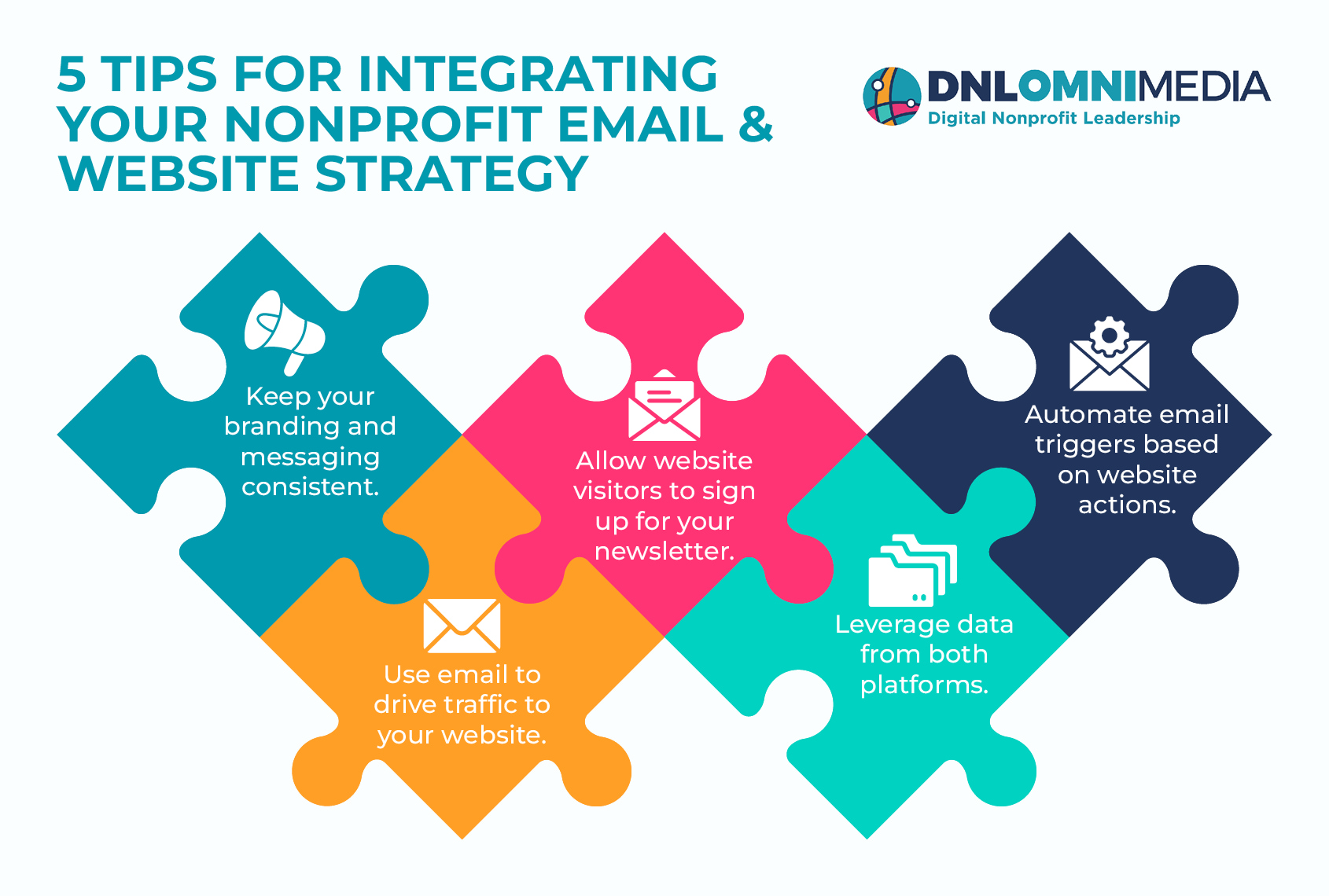
Think about your nonprofit’s team. Each staff member has unique strengths. When you work together, everyone brings new ideas and perspectives that enhance your organization’s operations and allow you to uphold your mission in fresh and innovative ways.
This concept also translates to marketing. As a nonprofit, you likely use a variety of methods to promote your services and gain more support—two of the most common being email and website marketing. While you can keep email and website marketing separate and still see success, combining the two offers unmatched insights and results.
In this article, we’ll provide five tips that enable you to seamlessly integrate your nonprofit email and website marketing strategies. That way, both methods can inform each other, taking your marketing efforts to the next level. Let’s get started!

1. Keep your branding and messaging consistent.
Your branding and voice are what make your content recognizable. By aligning your branding and messaging across both email and website content, you can provide a cohesive user experience for your supporters.
To achieve powerful, cohesive branding, create guidelines so your team is on the same page. These standards may include details about:
- Color schemes
- Logos
- Image style
- Tone of voice
- Messaging themes
When your content’s branding aligns across all platforms, you’ll not only create consistency but also build trust with your audience. Your supporters should be able to quickly identify emails and website pages as belonging to your organization. As a result, they’ll be able to distinguish your content from spam, increasing the likelihood that they’ll engage with the emails you send or information you publish online.
Kanopi’s healthcare website design guide points to the National Women’s Health Network’s website as an example of bold, consistent branding that “highlights its target audience and invites visitors to explore the organization’s mission, vision, and values.”
2. Use email to drive traffic to your website.
While it’s important to create educational emails that inform your supporters about your organization’s mission and relevant topics, you should also send promotional emails intended to drive website traffic.
Make sure to include clear calls to action that link to relevant pages you’d like to highlight. For example, Getting Attention recommends developing a volunteer page with the following elements:
- Descriptions of open opportunities
- Registration form
- Images of volunteers in action
- Frequently asked questions (FAQs)
- Contact information
To promote this page, you could create an email series about your volunteer program that ultimately sends recipients to your volunteer page to increase registration. The call to action could be “Explore Our Volunteer Program” or “Become A Volunteer Today” to clearly indicate the desired action for recipients to take.
In addition to your volunteer page, you may drive traffic to blog articles, donation forms, or event registration pages depending on your organization’s current priorities and goals.
3. Allow website visitors to sign up for your newsletter.
Using email to promote your website is a surefire way to integrate the two methods, but the reverse is also true. Your website is a stellar tool for increasing newsletter registrations.
The best nonprofit websites create opportunities for interaction and further engagement. By promoting your newsletter on your website, you invite visitors to dive deeper into your organization’s work and receive regular updates about your mission.
To encourage visitors to register for your newsletter, make sure you:
- Simplify the sign-up process. Limit the registration form to only necessary fields, such as name and email address. This will expedite the sign-up process and avoid collecting excess information that will clutter your supporter database.
- Explain the benefits of joining. Tell supporters exactly what they’ll get out of your newsletter. Perhaps you’ll send updates on ongoing projects, helpful resources and blog articles, invitations to upcoming events, or exclusive insights into how your organization runs.
- Use a CMS that allows you to integrate forms. Easily facilitate newsletter registration with a fully embedded form. Look for a content management system (CMS) that allows you to develop, customize, and add forms to your website.
In addition to a dedicated newsletter registration page, make sure you promote your newsletter throughout your website using pop-ups, sidebar forms, and your homepage to increase visibility and bolster the chances that interested users will sign up.
4. Leverage data from both platforms.
Both your email marketing and website platforms likely produce insightful analytics that you can use to improve your approach to each tactic. Why not combine the two data pools?
When you integrate your website analytics with your email platform, you can use the data generated from both platforms to inform each other. For example, if someone reads several articles on your blog about the climate crisis, you can send them an email with actionable steps they can take to become more eco-friendly.
This level of personalization offers supporters an enhanced experience and helps connect them with resources and branches of your organization they’re most likely to be interested in. Store any useful insights you discover in your constituent relationship management platform (CRM) so you can segment your supporters into relevant groups and reach out with information and opportunities that resonate with them.
5. Automate email triggers based on website actions.
In addition to signing up for your newsletter, there are likely forms on your website for other purposes, such as downloading a resource, registering to volunteer, or donating. Engage supporters who complete these forms by sending automated emails based on the actions they’ve taken on your website.
For example, if someone signs up for an event, they may receive an email sequence that includes information about the event’s speakers, sponsors, itinerary, and goals. As a result, you can continuously interact with supporters leading up to the event, building excitement and reminding them of their commitment to attend.
With these automated email streams, you can also offer supporters the opportunity to sign up for your newsletter to stay informed about additional opportunities. That way, you target people who have already demonstrated interest in being actively involved in your organization and encourage them to remain connected.
These days, nonprofits are dedicating increasingly more time to their digital strategy to acquire new supporters and build upon existing relationships. Take your approach to the next level by allowing your marketing methods to inform each other.
When you integrate your email and website strategy, you gain a more comprehensive understanding of your supporters, allowing you to target them on a more personal level and help them engage with your nonprofit in the ways they prefer. As a result, you’ll share your nonprofit’s mission in innovative ways and inspire long-lasting support.
